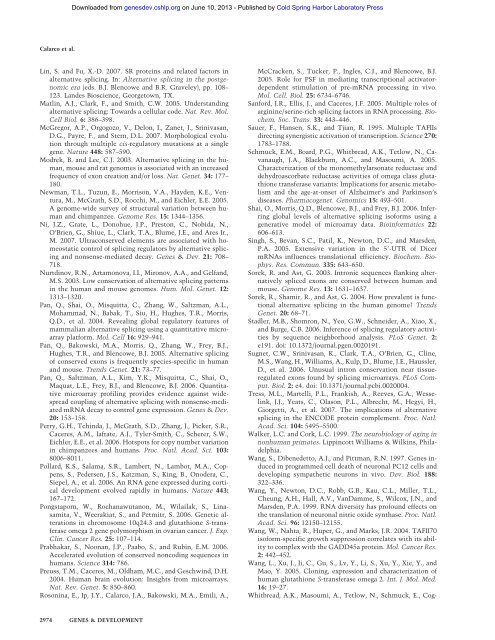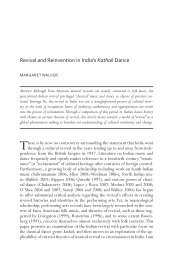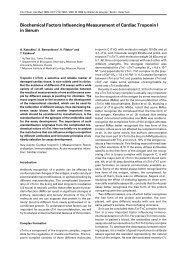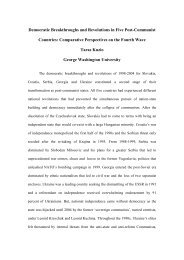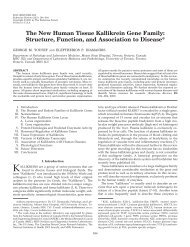Calarco et al 2007 - University of Toronto
Calarco et al 2007 - University of Toronto
Calarco et al 2007 - University of Toronto
- No tags were found...
Create successful ePaper yourself
Turn your PDF publications into a flip-book with our unique Google optimized e-Paper software.
Downloaded from genesdev.cshlp.org on June 10, 2013 - Published by Cold Spring Harbor Laboratory Press<strong>C<strong>al</strong>arco</strong> <strong>et</strong> <strong>al</strong>.Lin, S. and Fu, X.-D. <strong>2007</strong>. SR proteins and related factors in<strong>al</strong>ternative splicing. In: Alternative splicing in the postgenomicera (eds. B.J. Blencowe and B.R. Graveley), pp. 108–123. Landes Bioscience, Georg<strong>et</strong>own, TX.Matlin, A.J., Clark, F., and Smith, C.W. 2005. Understanding<strong>al</strong>ternative splicing: Towards a cellular code. Nat. Rev. Mol.Cell Biol. 6: 386–398.McGregor, A.P., Orgogozo, V., Delon, I., Zan<strong>et</strong>, J., Srinivasan,D.G., Payre, F., and Stern, D.L. <strong>2007</strong>. Morphologic<strong>al</strong> evolutionthrough multiple cis-regulatory mutations at a singlegene. Nature 448: 587–590.Modrek, B. and Lee, C.J. 2003. Alternative splicing in the human,mouse and rat genomes is associated with an increasedfrequency <strong>of</strong> exon creation and/or loss. Nat. Gen<strong>et</strong>. 34: 177–180.Newman, T.L., Tuzun, E., Morrison, V.A., Hayden, K.E., Ventura,M., McGrath, S.D., Rocchi, M., and Eichler, E.E. 2005.A genome-wide survey <strong>of</strong> structur<strong>al</strong> variation b<strong>et</strong>ween humanand chimpanzee. Genome Res. 15: 1344–1356.Ni, J.Z., Grate, L., Donohue, J.P., Preston, C., Nobida, N.,O’Brien, G., Shiue, L., Clark, T.A., Blume, J.E., and Ares Jr.,M. <strong>2007</strong>. Ultraconserved elements are associated with homeostaticcontrol <strong>of</strong> splicing regulators by <strong>al</strong>ternative splicingand nonsense-mediated decay. Genes & Dev. 21: 708–718.Nurtdinov, R.N., Artamonova, I.I., Mironov, A.A., and Gelfand,M.S. 2003. Low conservation <strong>of</strong> <strong>al</strong>ternative splicing patternsin the human and mouse genomes. Hum. Mol. Gen<strong>et</strong>. 12:1313–1320.Pan, Q., Shai, O., Misquitta, C., Zhang, W., S<strong>al</strong>tzman, A.L.,Mohammad, N., Babak, T., Siu, H., Hughes, T.R., Morris,Q.D., <strong>et</strong> <strong>al</strong>. 2004. Reve<strong>al</strong>ing glob<strong>al</strong> regulatory features <strong>of</strong>mamm<strong>al</strong>ian <strong>al</strong>ternative splicing using a quantitative microarrayplatform. Mol. Cell 16: 929–941.Pan, Q., Bakowski, M.A., Morris, Q., Zhang, W., Frey, B.J.,Hughes, T.R., and Blencowe, B.J. 2005. Alternative splicing<strong>of</strong> conserved exons is frequently species-specific in humanand mouse. Trends Gen<strong>et</strong>. 21: 73–77.Pan, Q., S<strong>al</strong>tzman, A.L., Kim, Y.K., Misquitta, C., Shai, O.,Maquat, L.E., Frey, B.J., and Blencowe, B.J. 2006. Quantitativemicroarray pr<strong>of</strong>iling provides evidence against widespreadcoupling <strong>of</strong> <strong>al</strong>ternative splicing with nonsense-mediatedmRNA decay to control gene expression. Genes & Dev.20: 153–158.Perry, G.H., Tchinda, J., McGrath, S.D., Zhang, J., Picker, S.R.,Caceres, A.M., Iafrate, A.J., Tyler-Smith, C., Scherer, S.W.,Eichler, E.E., <strong>et</strong> <strong>al</strong>. 2006. Hotspots for copy number variationin chimpanzees and humans. Proc. Natl. Acad. Sci. 103:8006–8011.Pollard, K.S., S<strong>al</strong>ama, S.R., Lambert, N., Lambot, M.A., Coppens,S., Pedersen, J.S., Katzman, S., King, B., Onodera, C.,Siepel, A., <strong>et</strong> <strong>al</strong>. 2006. An RNA gene expressed during cortic<strong>al</strong>development evolved rapidly in humans. Nature 443:167–172.Pongstaporn, W., Rochanawutanon, M., Wilailak, S., Linasamita,V., Weerakiat, S., and P<strong>et</strong>mitr, S. 2006. Gen<strong>et</strong>ic <strong>al</strong>terationsin chromosome 10q24.3 and glutathione S-transferaseomega 2 gene polymorphism in ovarian cancer. J. Exp.Clin. Cancer Res. 25: 107–114.Prabhakar, S., Noonan, J.P., Paabo, S., and Rubin, E.M. 2006.Accelerated evolution <strong>of</strong> conserved noncoding sequences inhumans. Science 314: 786.Preuss, T.M., Caceres, M., Oldham, M.C., and Geschwind, D.H.2004. Human brain evolution: Insights from microarrays.Nat. Rev. Gen<strong>et</strong>. 5: 850–860.Rosonina, E., Ip, J.Y., <strong>C<strong>al</strong>arco</strong>, J.A., Bakowski, M.A., Emili, A.,McCracken, S., Tucker, P., Ingles, C.J., and Blencowe, B.J.2005. Role for PSF in mediating transcription<strong>al</strong> activatordependentstimulation <strong>of</strong> pre-mRNA processing in vivo.Mol. Cell. Biol. 25: 6734–6746.Sanford, J.R., Ellis, J., and Caceres, J.F. 2005. Multiple roles <strong>of</strong>arginine/serine-rich splicing factors in RNA processing. Biochem.Soc. Trans. 33: 443–446.Sauer, F., Hansen, S.K., and Tjian, R. 1995. Multiple TAFIIsdirecting synergistic activation <strong>of</strong> transcription. Science 270:1783–1788.Schmuck, E.M., Board, P.G., Whitbread, A.K., T<strong>et</strong>low, N., Cavanaugh,J.A., Blackburn, A.C., and Masoumi, A. 2005.Characterization <strong>of</strong> the monom<strong>et</strong>hylarsonate reductase anddehydroascorbate reductase activities <strong>of</strong> omega class glutathion<strong>et</strong>ransferase variants: Implications for arsenic m<strong>et</strong>abolismand the age-at-ons<strong>et</strong> <strong>of</strong> Alzheimer’s and Parkinson’sdiseases. Pharmacogen<strong>et</strong>. Genomics 15: 493–501.Shai, O., Morris, Q.D., Blencowe, B.J., and Frey, B.J. 2006. Inferringglob<strong>al</strong> levels <strong>of</strong> <strong>al</strong>ternative splicing is<strong>of</strong>orms using agenerative model <strong>of</strong> microarray data. Bioinformatics 22:606–613.Singh, S., Bevan, S.C., Patil, K., Newton, D.C., and Marsden,P.A. 2005. Extensive variation in the 5-UTR <strong>of</strong> DicermRNAs influences translation<strong>al</strong> efficiency. Biochem. Biophys.Res. Commun. 335: 643–650.Sorek, R. and Ast, G. 2003. Intronic sequences flanking <strong>al</strong>ternativelyspliced exons are conserved b<strong>et</strong>ween human andmouse. Genome Res. 13: 1631–1637.Sorek, R., Shamir, R., and Ast, G. 2004. How prev<strong>al</strong>ent is function<strong>al</strong><strong>al</strong>ternative splicing in the human genome? TrendsGen<strong>et</strong>. 20: 68–71.Stadler, M.B., Shomron, N., Yeo, G.W., Schneider, A., Xiao, X.,and Burge, C.B. 2006. Inference <strong>of</strong> splicing regulatory activitiesby sequence neighborhood an<strong>al</strong>ysis. PLoS Gen<strong>et</strong>. 2:e191. doi: 10.1372/journ<strong>al</strong>.pgen.0020191.Sugn<strong>et</strong>, C.W., Srinivasan, K., Clark, T.A., O’Brien, G., Cline,M.S., Wang, H., Williams, A., Kulp, D., Blume, J.E., Haussler,D., <strong>et</strong> <strong>al</strong>. 2006. Unusu<strong>al</strong> intron conservation near tissueregulatedexons found by splicing microarrays. PLoS Comput.Biol. 2: e4. doi: 10.1371/journ<strong>al</strong>.pcbi.0020004.Tress, M.L., Martelli, P.L., Frankish, A., Reeves, G.A., Wesselink,J.J., Yeats, C., Olason, P.L., Albrecht, M., Hegyi, H.,Giorg<strong>et</strong>ti, A., <strong>et</strong> <strong>al</strong>. <strong>2007</strong>. The implications <strong>of</strong> <strong>al</strong>ternativesplicing in the ENCODE protein complement. Proc. Natl.Acad. Sci. 104: 5495–5500.W<strong>al</strong>ker, L.C. and Cork, L.C. 1999. The neurobiology <strong>of</strong> aging innonhuman primates. Lippincott Williams & Wilkins, Philadelphia.Wang, S., Dibened<strong>et</strong>to, A.J., and Pittman, R.N. 1997. Genes inducedin programmed cell death <strong>of</strong> neuron<strong>al</strong> PC12 cells anddeveloping sympath<strong>et</strong>ic neurons in vivo. Dev. Biol. 188:322–336.Wang, Y., Newton, D.C., Robb, G.B., Kau, C.L., Miller, T.L.,Cheung, A.H., H<strong>al</strong>l, A.V., VanDamme, S., Wilcox, J.N., andMarsden, P.A. 1999. RNA diversity has pr<strong>of</strong>ound effects onthe translation <strong>of</strong> neuron<strong>al</strong> nitric oxide synthase. Proc. Natl.Acad. Sci. 96: 12150–12155.Wang, W., Nahta, R., Huper, G., and Marks, J.R. 2004. TAFII70is<strong>of</strong>orm-specific growth suppression correlates with its abilityto complex with the GADD45a protein. Mol. Cancer Res.2: 442–452.Wang, L., Xu, J., Ji, C., Gu, S., Lv, Y., Li, S., Xu, Y., Xie, Y., andMao, Y. 2005. Cloning, expression and characterization <strong>of</strong>human glutathione S-transferase omega 2. Int. J. Mol. Med.16: 19–27.Whitbread, A.K., Masoumi, A., T<strong>et</strong>low, N., Schmuck, E., Cog-2974 GENES & DEVELOPMENT


